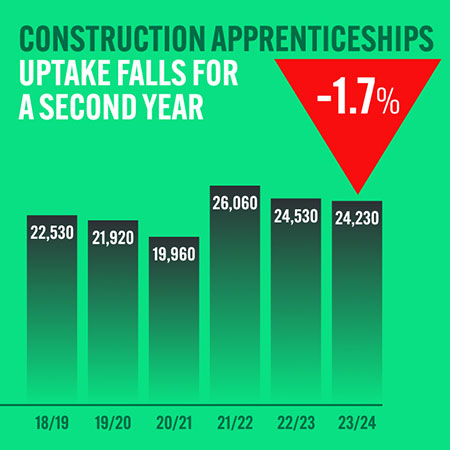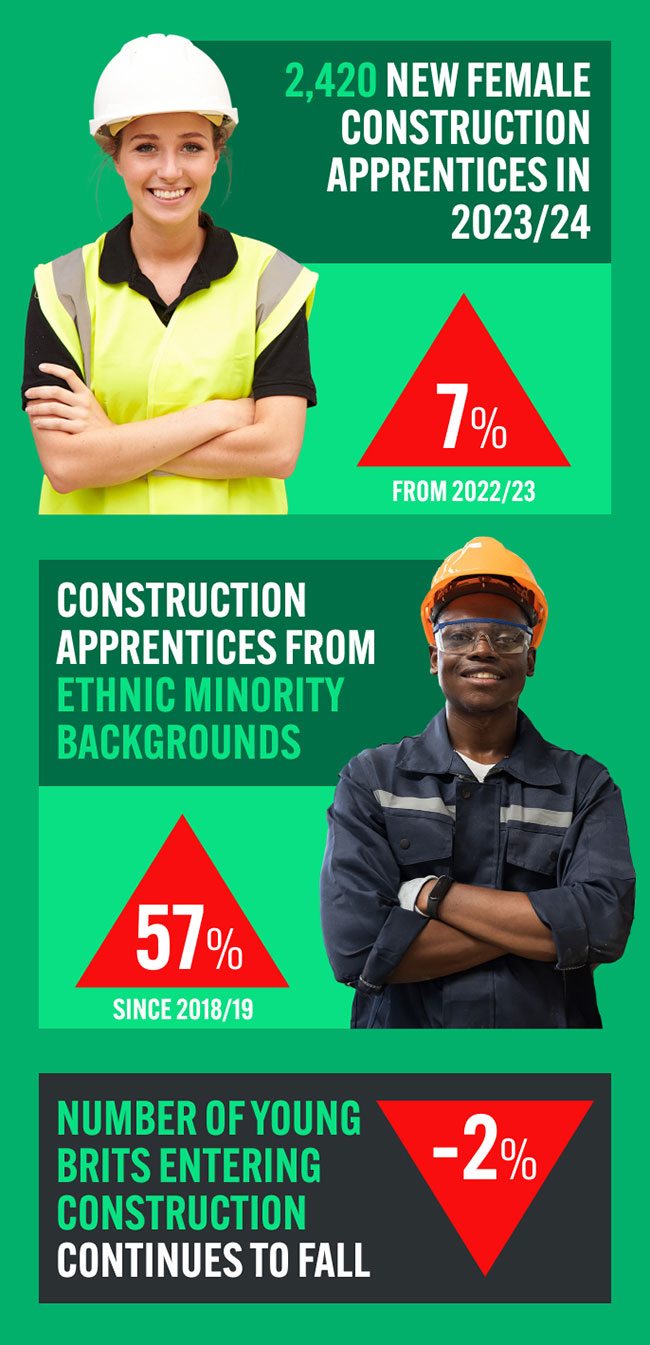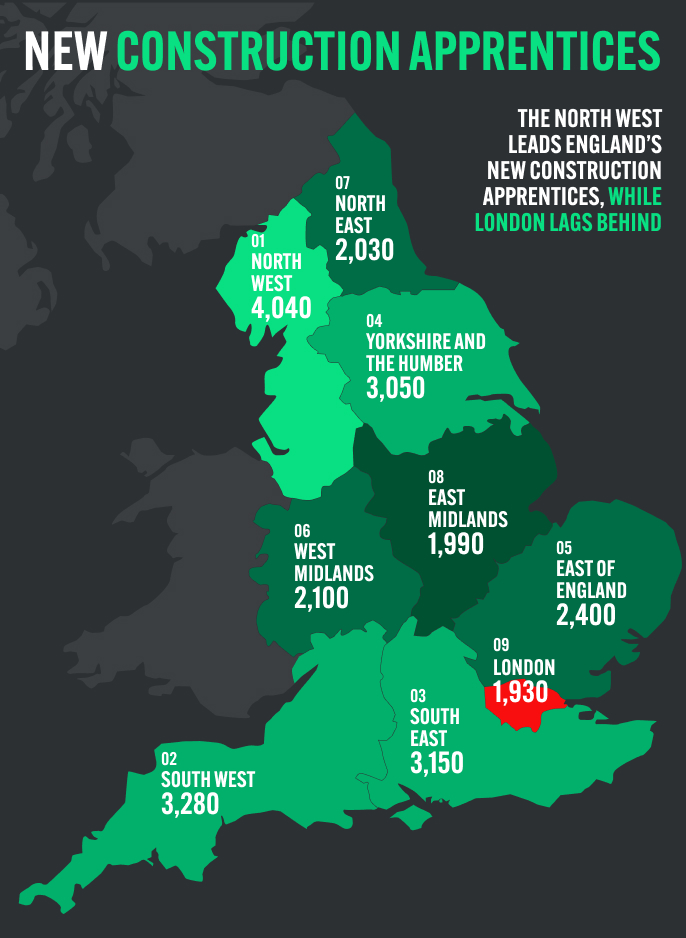Report: State of Construction Apprenticeships in 2025

Our annual report highlights a significant construction skills gap in the UK
Analysing the state of the UK’s construction skills gap, our latest research has revealed a 1.4% decline in new construction apprentices over the last year; this follows a 5% drop from the year before.
After consecutive years of lower entry figures for the sector, Protrade’s State of Construction Apprenticeship Report (2025) demonstrates the stark concerns about the industry’s ability to attract new talent.
This follows the recent UK government announcement discussing plans to build 1.5 million new homes over the next five years, which places pressure on an existing sector that is already estimated to have 36,000 vacancies currently waiting to be filled
By 2030, it is estimated that 28,652 people are expected to join construction apprenticeships. As a result, a sharp rise in construction apprenticeships may be needed to support growth in the sector.
Key Findings
- 2,420 new female apprentices joined the sector in 2023/2024 – an increase of 7% from 2022/2023
- 1.4% decline in new construction apprentices joining the industry in 2023/24, with 24,230 individuals enrolling in new courses, down from 24,530 the previous year
- The North West of England (4,040) has the highest number of new apprenticeship enrolments in 2023/24.
- London (1,930) ranks last for construction apprenticeship enrolments in 2023/24.
- Apprentices from ethnic backgrounds increased by 1% compared with 2022/23, with 1,900 new learners from diverse communities, representing a 57% increase since 2018/19.
1.7% decrease in UK uptake presents a second year of stagnation for construction apprenticeships
| Year | Number of new construction apprentices |
| 2018/19 | 22,530 |
| 2019/20 | 21,920 |
| 2020/21 | 19,960 |
| 2021/22 | 26,060 |
| 2022/23 | 24,530 |
| 2023/24 | 24,230 |
 Our 2025 State of Construction Report has revealed that interest in construction is waning for a second year in a row, with a 1.4% decrease in new apprentices over the last year.
Our 2025 State of Construction Report has revealed that interest in construction is waning for a second year in a row, with a 1.4% decrease in new apprentices over the last year.
2023/2024 figures now represent a 14% decline since the 21/22 peak of 26,060 people beginning a construction apprenticeship, demonstrating that the post-covid uptick in new admissions to the industry is officially over.
While 2023/24’s figures haven’t reached the pit seen in 2020/21 (19,960), the current numbers are still nowhere near the amount needed to improve the 250,000 worker shortfall to complete the UK government’s plans.
Women now represent over one in ten construction apprenticeships
| Number of new construction apprentices | ||
| Year | Male | Female |
| 2018/19 | 21,080 | 1,450 |
| 2019/20 | 20,190 | 1,730 |
| 2020/21 | 18,470 | 1,490 |
| 2021/22 | 24,140 | 1,930 |
| 2022/23 | 22,270 | 2,260 |
| 2023/24 | 21,810 | 2,420 |
Across the UK, 2023/24 saw 2,420 women entering the construction industry (an increase of 7% on the previous year), making it the best year for new female apprentices entering the sector.
Women now represent over 10% of the construction apprenticeship intake which is a historic high for the sector, increasing from 9.2% of all apprentices in 2022/23.
However, this rise in female entrants sits against a backdrop of reduced apprenticeship starters amongst male counterparts, with 460 fewer male apprentices joining the sector in 2023/24 from 2022/23’s intake.

43% increase in diverse communities’ apprenticeship uptake from 5 years ago
| Year | Number of new construction apprentices from ethnic backgrounds | Change on year before as a percentage |
| 2018/19 | 1,210 | N/A |
| 2019/20 | 1,400 | 16% increase |
| 2020/21 | 1,190 | 15% decrease |
| 2021/22 | 1,690 | 42% increase |
| 2022/23 | 1,900 | 12% increase |
| 2023/24 | 1,920 | 1% increase |
The sector saw 1,920 new apprentices from ethnic minority backgrounds, a slight increase (120 pupils) on 2022/23’s intake. The 2023/24 intake also represents a 43% increase in ethnic minorities starting construction apprenticeships compared with 5 years ago, a year in which only 1,210 new entrants from diverse backgrounds began an apprenticeship in this field.
However, the rate of increase of those from ethnic backgrounds is increasing at a much slower rate than the past two years, comparing this year’s 1% increase with increases of 42% and 12% for 2021/22 and 2022/23 respectively.
Number of young Brits entering construction continues to fall by 2%
| Number of new construction apprentices | |||
| Age | 2021/22 | 2022/23 | 2023/24 |
| 16 | 4,520 | 4,160 | 4,010 |
| 17 | 4,250 | 3,820 | 3,760 |
| 18 | 4,500 | 4,410 | 4,370 |
| 19-24 | 9,160 | 8,310 | 8,310 |
| 25-34 | 2,650 | 2,530 | 2,490 |
| 35-44 | 690 | 850 | 850 |
| 45-59 | 280 | 400 | 400 |
| 60+ | 20 | 50 | 40 |
Last year saw a drop in construction apprenticeship entrants aged 18 and under, with 16 year old apprenticeship numbers dropping by 4% in the past year. The intake also dropped for 17 year olds (2%) and 18 year olds (1%).
19-24 year olds still make up the highest proportion of new intakes, with 8,310 from this age group entering the sector in the past year. However, this figure represents a decline of 9% since 2021/22.
North West leads England’s new construction apprentices, and London lags behind
| Rank | Region | Number of new construction apprentices in 2023-24 |
| 1 | North West | 4,040 |
| 2 | South West | 3,280 |
| 3 | South East | 3,150 |
| 4 | Yorkshire and The Humber | 3,050 |
| 5 | East of England | 2,400 |
| 6 | West Midlands | 2,100 |
| 7 | North East | 2,030 |
| 8 | East Midlands | 1,990 |
| 9 | London | 1,930 |

North West England leads the charge with 4,040 new recruits joining the sector in the past year.
This is 23% higher than the runner up region, South West, that saw 3,280 new starters. South East England ranked third with 3,150 new starters, closely followed by Yorkshire and the Humber (3,050) and East of England (2,400).
London officially saw the fewest number of new construction apprentices, with only 1,930 people beginning a course between 2023/24. This was closely followed by the East Midlands (1,990), and the North East (2,030).
Three Important Steps the UK Must Take to Close the Construction Skills Gap
As our new report sets out, there is a significant skills gap emerging between the demand for construction roles and a decline in new construction apprentices joining the sector.
Des Duddy, our Joint Managing Director, sets out key steps the industry should take to ensure the construction sector boosts apprenticeship numbers:
- Change the perception of the sector – talk about salaries and benefits
The construction industry should work together to transform the perception of the construction sector. Apprenticeships are becoming better paid, 18% rise in the minimum hourly rate for an apprenticeship planned for April 2025, taking earnings to £7.55 an hour.
In addition to this, salaries of construction professionals are consistently high, with the sector salary average being £42,500. Moreover, an experienced bricklayer could expect to earn £45,000 per year whilst an experienced building surveyor could earn £55,000 annually – significantly higher than the UK median average earnings, which were £37,340 in 2024. However, 57% of the public assume construction salaries are below the UK average. Better communicating the economic opportunities of construction is a step that the industry must begin to take more readily. - Attract more women into construction
Despite a record breaking year for women entering construction, there still remains huge opportunity to attract more females into this space, with construction apprenticeships still lagging 7% behind STEM apprenticeships more broadly in terms of female representation.
Solutions to boosting apprenticeships amongst females may be to offer greater flexibility in what can often be quite rigid apprenticeship structures, whilst also communicating powerful and relatable case studies of young women succeeding in construction – social media is a great avenue for this. - Start engaging Gen Alpha now
Gen Alpha, those who are 14 years and below, of all demographics, must be introduced to the opportunities and benefits that construction work includes. This includes showcasing the sheer variety of different job roles that are available within construction, as well as the benefits to this learning environment compared with further education alternatives.
Important influencers of these age groups include teachers as well as parents and carers, encouraging those groups to view construction differently may be just as impactful as engaging school-aged children themselves.
Image credit: Unsplash. Infographics provided have been supplied by Protrade

Joint Managing Director, Protrade
Des has over 30 years of experience at Protrade, having worked in the capacity of Sales Co-ordinator, Account Manager, and product development, culminating in being appointed Joint Managing Director in 2018.



